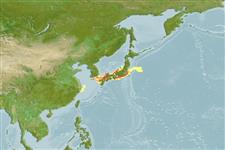>
Ophidiiformes (Cusk eels) >
Bythitidae (Livebearing brotulas)
Etymology: Parabrotula: Greek, para = the side of + Latin, brotula, -ae = little, bud, shoot (Ref. 45335); tanseimaru: Named after R/V Tansei Maru.
Eponymy: ‘Tansei Maru’ is the name of a research vessel, owned by the Ocean Research Institute, University of Tokyo (now Japan Marine Science and Technology Center), which was responsible for collecting the holotypes of the goby and false brotula. (Ref. 128868), visit book page.
More on authors: Miya & Nielsen.
Environment: milieu / climate zone / depth range / distribution range
Ökologie
seewasser bathypelagisch; tiefenbereich 0 - 1300 m (Ref. 34721). Deep-water
Northwest Pacific: Japan.
Size / Gewicht / Alter
Maturity: Lm ? range ? - ? cm
Max length : 5.0 cm SL Männchen/unbestimmt; (Ref. 34721); 5.0 cm SL (female)
Occurs in pseudoceanic bathypelagic depths. Feeds primarily on copepods (Ref. 34721). Viviparous (Ref. 34721).
Life cycle and mating behavior
Geschlechtsreife | Fortpflanzung | Ablaichen | Eier | Fecundity | Larven
Miya, M. and J.G. Nielsen, 1991. A new species of the deep-sea fish genus Parabrotula (Parabrotulidae) from Sagami Bay with notes on its biology. Jap. J. Ichthyol. 38(1):1-5. (Ref. 34721)
IUCN Rote Liste Status (Ref. 130435: Version 2024-2)
Bedrohung für Menschen
Harmless
Nutzung durch Menschen
Tools
Zusatzinformationen
Download XML
Internet Quellen
Estimates based on models
Preferred temperature (Ref.
123201): 0.7 - 16.4, mean 8.5 °C (based on 34 cells).
Phylogenetic diversity index (Ref.
82804): PD
50 = 0.8750 [Uniqueness, from 0.5 = low to 2.0 = high].
Bayesian length-weight: a=0.00813 (0.00246 - 0.02688), b=2.92 (2.67 - 3.17), in cm total length, based on LWR estimates for this (Sub)family-body shape (Ref.
93245).
Trophic level (Ref.
69278): 3.0 ±0.00 se; based on food items.
Widerstandsfähigkeit (Ref.
120179): hoch, Verdopplung der Population dauert weniger als 15 Monate. (Preliminary K or Fecundity.).
Fishing Vulnerability (Ref.
59153): Low vulnerability (10 of 100).
